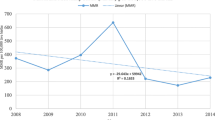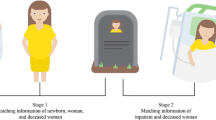Abstract
Objective In the absence of an adequate vital registration system in Ghana, the Navrongo demographic surveillance system (NDSS) established in 1993 presents a viable alternative to monitor, in a poor rural district, the UN Millennium Development Goal on maternal health (MDG) of reducing maternal mortality by 75% between 1990 and 2015. Methods Of the 518 women aged 12–49 years identified in the NDSS database to have died in the Kassena-Nankana district in the period January 2002–December 2004, spouses or family members completed verbal autopsy interviews for 516 female deaths. Results Of the 516 female deaths, 45 were identified as maternal deaths. 71% of the maternal deaths were attributed to direct maternal causes while 29% were due to indirect maternal causes. Abortion-related deaths were the most frequent cause of maternal deaths. The maternal mortality ratio for the period 2002–2004 was 373 maternal deaths per 100,000 live births indicating a 40% reduction of maternal mortality from the 1995–1996 level of 637 maternal deaths per 100,000 live births. However, the health-facility based maternal mortality ratio in the district (which excludes maternal deaths outside health facilities) was 141 maternal deaths per 100,000 live births for the period 2002–2004. Conclusion This district may be on track to achieve the MDG on maternal health. Ultimately, strengthening vital registration systems to provide timely information to policymakers should supersede the other methods of measuring maternal mortality.

Similar content being viewed by others
References
Hill, K., AbouZhar, C., & Wardlaw, T. (2001). Estimates of maternal mortality for 1995. Bulletin of the World Health Organization, 79, 182–193.
AbouZahr, C., & Wardlaw, T. (2003). Maternal mortality in 2000: Estimates developed by WHO, UNICEF and UNFPA.
United Nations Millennium Declaration. (2000). United Nations General Assembly New York, No. A/RES/55/2, 55th Sess. (Sept. 18, 2000).
WHO and UNICEF; Revised 1990 Estimates of Maternal Mortality: A new approach by WHO and UNICEF. World Health Organization (Geneva, 1996).
Twum-Baah, K. A. (1994). Infant, child and maternal mortality study in Ghana. Ghana Statistical Service, Ministry of Health, UNICEF, 1994. Report No.: AHG4567.
Smith, J. B., Fortney, J. A., Wong, E., Amatya, R., Coleman, N. A., & de Graft, J. J. (2001). Estimates of the maternal mortality ratio in two districts of the Brong-Ahafo region, Ghana. Bulletin of the World Health Organization, 79, 400–408.
AbouZahr, C., Wardlaw, T., & Hill, K. (2001). Maternal mortality in 1995: Estimates developed by WHO, UNICEF, UNFPA.
Stanton, C., Abderrahim, N., & Hill, K. (1997). DHS Maternal mortality indicators: An assessment of data quality and implications for data use. Calverton, Maryland USA, Macro International Inc., 1997. Report No.: 4.
Public Health Division; Ghana Health Service. Reproductive and Child Health Annual Report, 2003.
Ngom, P., Akweongo, P., Adongo, P., Bawah, A. A., & Binka, F. (1999). Maternal mortality among the Kassena-Nankana of northern Ghana. Studies in Family Planning, 30, 142–147.
Adjuik, M., Smith, T., Clark, S., Todd, J., Garrib, A., Kinfu, Y., Kahn, K., Mola, M., Ashraf, A., Masanja, H., Adazu, K., Sacarlal, J., Alam, N., Marra, A., Gbangou, A., Mwageni, E., & Binka, F. (2006). Cause-specific mortality rates in sub-Saharan Africa and Bangladesh. Bulletin of the World Health Organization, 84, 181–188.
Hill, K., El Arifeen, S., Koenig, M., Al Sabir, A., Jamil, K., & Raggers, H. (2006). How should we measure maternal mortality in the developing world? A comparison of household deaths and sibling history approaches. Bulletin of the World Health Organization, 84, 173–180.
World Health Organization. (1993). International statistical classification of diseases and related health problems (10th Revision). World Health Organization: Geneva.
Quigley, M. A., Chandramohan, D., Setel, P., Binka, F., & Rodrigues, L. C. (2000). Validity of data-derived algorithms for ascertaining causes of adult death in two African sites using verbal autopsy. Tropical Medicine and International Health, 5, 33–39.
Ghana Statistical Service, Noguchi Memorial Institute for Medical Research and ORC Macro. Ghana Demographic and Health Survey 2003. Calverton (Maryland): GSS, NMIMR and ORC Macro, 2004.
Forgor, A. A., Leimkugel, J., Hodgson, A., Bugri, A., Dangy, J. P., Gagneux, S., Smith, T., & Pluschke, G. (2005). Emergence of W135 meningococcal meningitis in Ghana. Tropical Medicine and International Health 10, 1229–1234.
Debpuur, C., Chirawurah, D., Wontuo, P., Welaga, P., KangsangbataC, Seidu, N., Hodgson, A., & Binka, F. The Navrongo Demographic Surveillance System 2002 Report to the Rockefeller Foundation. Community Health and Family Planning Project; Jul 2002. Report No.: 47.
Mills, S., Williams, J. E, Adjuik, M., & Hodgson, A. (2007). Use of health professionals for delivery following the availability of free obstetric care in northern Ghana. Maternal and Child Health Journal (Forthcoming).
Central Bureau of Statistics Kenya, Ministry of Health Kenya, and ORC Macro. Kenya Demographic and Health Survey 2003. Calverton (Maryland): CBS, MOH, and ORC Macro; 2004.
Ministry of Health and Social Welfare Lesotho, Bureau of Statistics Lesotho, and ORC Macro. Lesotho Demographic and Health Survey 2004. Calverton (Maryland): MOH, BOS, and ORC Macro; 2005.
Badan Pusat Statistik-Statistics Indonesia and ORC Macro. Indonesia Demographic and Health Survey 2002–2003. Calverton (Maryland): BPS and ORC Macro; 2003.
Cayemittes, Michel, Marie Florence Placide, Bernard Barrère, Soumaïla Mariko, Blaise Sévère. Enquête Mortalité, Morbidité et Utilisation des Services, Haïti 2000. Calverton (Maryland): Ministère de la Santé Publique et de la Population, Institut Haïtien de l’Enfance et ORC Macro, 2001.
Chandramohan, D., Rodrigues, L. C., Maude, G. H., & Hayes, R. J. (1998). The validity of verbal autopsies for assessing the causes of institutional maternal death. Studies in Family Planning, 29, 414–422.
Chandramohan, D., Setel, P., & Quigley, M. (2001). Effect of misclassification of causes of death in verbal autopsy: Can it be adjusted? Internal Journal of Epidemiology, 30, 509–514.
Soleman, N., Chandramohan, D., & Shibuya, K. (2006). Verbal autopsy: current practices and challenges. Bulletin of the World Health Organization, 84, 239–245.
Lulu, K., & Berhane, Y. (2005). The use of simplified verbal autopsy in identifying causes of adult death in a predominantly rural population in Ethiopia. BMC Public Health, 5, 58.
Stewart, M. K., & Festin, M. (1995). Validation study of women’s reporting and recall of major obstetric complications treated at the Philippine General Hospital. International Journal of Gynaecology and Obstetrics, 48(Suppl), S53–S66.
Sloan, N. L., Langer, A., Hernandez, B., Romero, M., & Winikoff, B. (2001). The etiology of maternal mortality in developing countries: What do verbal autopsies tell us? Bulletin of the World Health Organization, 79, 805–810.
Debpuur, C., Phillips, J. F., Jackson, E. F., Nazzar, A., Ngom, P., & Binka, F. N. (2002). The impact of the Navrongo project on contraceptive knowledge and use, reproductive preferences, and fertility. Studies in Family Planning, 33, 141–164.
Magadi, M., Diamond, I., & Madise, N. (2001). Analysis of factors associated with maternal mortality in Kenyan hospitals. Journal of Biosocial Science, 33, 375–389.
Setel, P., Whiting, D., Hemed, Y., & Alberti, K. G. (2000). Educational status is related to mortality at the community level in three areas of Tanzania, 1992–1998. Journal of Epidemiology and Community Health, 54, 936–937.
Shen, C., & Williamson, J. B. (1999). Maternal mortality, women’s status, and economic dependency in less developed countries: A cross-national analysis. Social Science and Medicine, 49(2), 197–214.
Baiden, F., Hodgson, A., Adjuik, M., Adongo, P., Ayaga, B., & Binka, F. (2006). Trend and causes of neonatal mortality in the Kassena-Nankana district of northern Ghana, 1995–2002. Tropical Medicine and International Health, 11, 532–539.
Stanton, C., Hobcraft, J., Hill, K., Kodjogbe, N., Mapeta, W. T., Munene, F., Naghavi, M., Rabeza, V., Sisouphanthong, B., & Campbell, O. (2001). Every death counts: Measurement of maternal mortality via a census. Bulletin of the World Health Organization, 79, 657–664.
Hill, K. (2006). Making deaths count. Bulletin of the World Health Organization, 84, 162.
Acknowledgement
We wish to thank all Navrongo Health Research Centre staff who contributed to the data collection and entry. We acknowledge Peter Wontuo for the supervision of the data entry process and Martin Adjuik for the person-years estimates. We are grateful to Eduard Bos and Elizabeth Lule of the World Bank for their guidance. We are appreciative of the financial support of the World Bank-Netherlands Partnership Program. The views expressed in this paper are solely those of the authors and do not represent the official positions of the affiliated institutions.
Author information
Authors and Affiliations
Corresponding author
Rights and permissions
About this article
Cite this article
Mills, S., Williams, J.E., Wak, G. et al. Maternal Mortality Decline in the Kassena-Nankana District of Northern Ghana. Matern Child Health J 12, 577–585 (2008). https://doi.org/10.1007/s10995-007-0289-x
Received:
Accepted:
Published:
Issue Date:
DOI: https://doi.org/10.1007/s10995-007-0289-x




